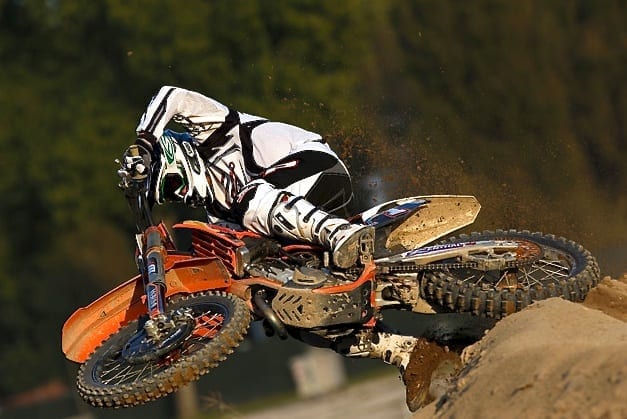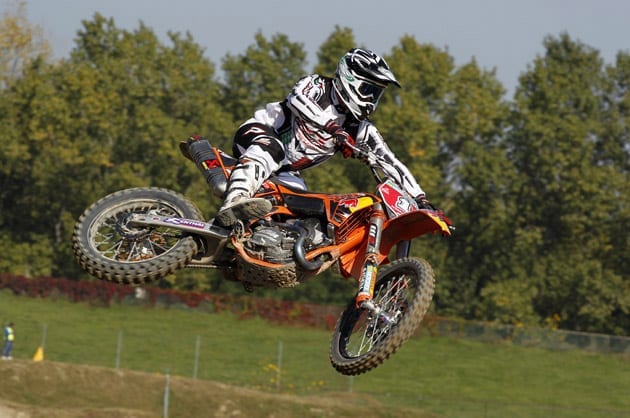Gassers PROficient 2011 bikes
By TMX Archives on 18th Nov 10

THE Gas Gas PRO range is well-known to all trials riders and there are thousands of them out there up and down the country. And the state-of-the-art 2011 range is only going to add to that number.
In 2009 the PRO range (headed by the awesome specced Raga Replica) was treated to an all-new chassis, which set new standards in lightness for a production trials bike. The tubular steel chassis was an object lesson in keeping things simple and the geometry and weight distribution were subtly tweaked to give the optimum balance, and in doing so the designers removed the Gassers' tendency to be a little twitchy at the front.
For 2010 the factory basically left well alone, apart from going back to the popular default mainly red colour scheme which is always a winner.
But for 2011 the Gerona factory has been right on the development case again with a serious update that includes several major changes - and all to the good.
Firstly, there's an all-new perimeter chassis that utilises basically the 2010 main frame loop, but incorporating many quality 'micro-fused' (cast) parts coupled with a completely re-designed rear end.
The rear cross-piece, which incorporates the top shock mount, is now a lovely tubular steel external arch that is actually incorporated in the styling with cutaways in the plastics to show it off. This is both simple and strong - and allowed the factory to then address several components that the design team had been itching to get at. Both the airbox and exhaust system are completely new.
The exhaust retains its lovely titanium front pipe but then flows through an all-new middle box and tail-pipe. The mid-box is more robust and features stronger mounts while the rear-box includes a replaceable end-cap for when you damage it in a loop-out! The airbox is definitely the best yet on a Gasser with clever design that should surely keep all the muck and water out - short of actually drowning the bike.
The whole frame is also actually wider in the footrest area - about 1.2mm - which was at the suggestion of factory rider Adam Raga - to allow better control as it encourages you to grip the bike between your legs.
Other changes include a 'ribbed' rear wheel rim (external spoke fastening) which needs no central sealing band (hooray) and a lighter front rim. There's also a new rear brake master cylinder with the reservoir built-in plus lots of detail stuff.
The unique PRO engine and gearbox, which magically produces six ratios from just four pairs of gears, remains pretty much untouched although importer John Shirt tells us that the factory is constantly refining the unit.
With the latest Marzocchi forks up front and a Sachs shock working through a linkage and aluminium swinging arm, the 2011 Gasser PRO, in its usual four-bike format, 125/ 250/ 280/ 300 is ready to rock...
Words: Woody Hole
Pictures: Jason Bellinger
PRO 125
THE 125cc model, from any manufacturer, used to be the one you spent the least time on. Frankly, they weren't very good and sales were minimal so no-one was really interested.
What a difference these days! Ever since the 'youth' riders - up-to-17 years of age - were restricted to 125cc engines, absolutely everyone along the chain has been galvanised. The factories have done an absolutely incredible job on their 125cc offerings over the past few years, Gas Gas right up there with the best, and to be absolutely honest the 125 is definitely not 'just' suitable for the youth market.
The Gas Gas 125 PRO is most definitely an option for an adult rider. I rode the 125 first and I reckon that the new rear-end is a massive improvement. That goes for all the models of course. It feels so much more sturdy and you can easily get hold of something to lift the bike around when you get stuck - like I do in the Scott!
It's a matter of taste, I know, but personally I love the look as well with the exposed chassis - a piece of clever design. It looks strong, which is good, and you can actually feel the difference in the frame width, it definitely adds to the feel and the stability. It is a genuine practical improvement.
The word for the 125 is 'light'. Absolutely everything about it is light, starting with kicking the motor into life which hardly requires a kick. The 125 is just so easy to ride. It feels light as a feather, all the controls barely require any effort and is just fun to ride.
Hawks Nest is, if you don't know, a steep, rocky hillside near Buxton with twists and turns and rock steps. Nothing could be easier than flicking the 125 around in such conditions.
The Gasser has a reputation for awesome revs and this remains true for 2011. It sings like a turbine at the top-end, but it also has bottom and mid-range power. I was blipping round in bottom, second and third and I probably weigh 14-stone - think of the power to weight advantage of a Youth rider probably half that weight.
The clutch is light and obviously gets a fair bit of stick on a 125, but it just soaks up the punishment.
As you'd expect, the suspension is set-up fairly soft and bouncy, just what the kids want. You don't have to ride it like a spring, it steers beautifully, but we know what kids are like!
If you haven't ridden a modern 125cc trials bike you would be amazed at what it can do. You can even get away with stuff that you never would on a bigger-engined model!
I was riding across a nasty adverse-cambered rock which was crumbly, like riding across ball bearings but the 125 just shot across, easier than when I tried the same on the other models.
If you are a youth rider you'll want one. If you are an adult you should really just forget the capacity and just have a test ride on one. You'll be amazed.
PRO 250
THE first of the adult bikes. I've a confession to make here - just before I tested the 2011 Raga a couple of months ago I was actually thinking of buying a 2010 model standard Gasser.
However, when I tested the 2011 Raga - with the new chassis - I just had to have one. So I bought a 250 - and finished the Scott Trial on it - so I do know this model pretty well.
The 250 is the default model for most customers and is as capable of looking after a raw Novice while at the same time being easily able to win a National trial with an Expert at the helm. If the watchword for the 125 is 'light' then the 250 has to be 'soft'. The power delivery is absolutely perfect for a trials bike being soft and forgiving, just building power with revs. There's no power step or peaky delivery, just lovely, useable power to cope with any situation.
The PRO chassis is now very planted and you can either ride just by steering or, if you want, hop the front (or back) end around a tight turn. Either is pretty easy to do. And you can tell the extra width in the mid-section over the previous models. It just helps with overall balance and stability. As with the 125 the suspension is set-up soft and lively without bouncing around all over the place. The exhaust note of the 250, as you would expect, is also soft and although the bigger engined models have more of a 'pop', it is controlled as the new exhaust system really delivers.
The Gas Gas six-speed box offers four ratios closely packed, all of which can be used in sections depending on what they are. There's then a jump to fifth for a cross-country ratio and another hop up to sixth for roadwork. On the 250 it doesn't really matter too much if you are a ratio too high or low in a section, chances are that the forgiving motor will alow you to easily get away with it.
The 250 has always been the model of choice and if anything the 2011 ofering simply reinforces that view. Great bike.
PRO 280
I'VE always had a big problem with the 280 and 300 Gas Gas models. My question is always: "Why?" And the factory doesn't make it any easier as it has continually pushed and pulled the power up and down the revs range between the two models trying to make them different.
Traditionally, I never liked the 280, then last year I felt that the 280 was just like a bigger 250 and surprise, surprise, I actually liked it.
This year though they seem to have abandoned that and made the engine really 'wick' and ultra responsive.
The chassis remains the same for all models of course, whether 125 or 300 so the only differences are in the engine power departments. So I had no probems with the riding or handling. But with such a quick power delivery, I really didn't find the 280 an easy ride. I was continually fighting it and trying to slow things down. It was harder to ride a straight line on rocks and I also found it tiring.
Now, if I was a teenage whiz-kid straight out of the youth ranks, I would probably be running off with one now. The 280 is everything that a clutch-mad, hopping and bopping young rider dreams of.
Flick it round a tight turn using the chassis and slighty suspension, then rev that motor up to full revs, drop the clutch and wham - straight up that six-foot step!
In a world of horses for courses this is just not my steed of choice.
PRO 300
NOW you're talking! Chalk and cheese compared with the 280. In short, in my mind this is a great bike. It has buckets of strong, smooth power and is easy to ride.
Don't rush in too fast though, I still think that you need to be a better rider, or at least a pretty fit rider, to get the most out of this bike.
The 300 Gasser used to be the choice for an older competitor, but for 2011, I reckon he would be much better off with the soft and forgiving 250.
The 300, while being very controllable, really needs a good, experienced fit lad to justify the means. It might feel good when you are back-street testing, or just having a five minute blip. But believe me if you are constantly riding sections the power will tire you where you could ride all day on the 250 or 125.
It is almost irrelevant what gear you select on the 300, it will simply eat-up sections if you are capable of riding it, whether plonking along in first or digging a trench with the rear tyre attacking a muddy hill in fourth gear. Southern riders love the 300 for their slippery hills and ditches.
It gets repetitive but yes, the suspension is soft and plush, just like the others.
I did give the 300 a bit of a caning on some of the bigger steps and while soft initially, the rear does stiffen-up as the linkage does its stuff and it didn't clank, clatter or bottom-out.
The brakes are good - the same on all models - offering good feel and they do exactly what you tell them to do.
The rear sports a really needed master cylinder design.
As I said at the start PRO 300 - Great bike!
CONCLUSION
I'VE been doing the trials tests for a good few years now and we often stand and look at a bike and think: "Surely they can't improve on that now, it's as small and light as you can go."
Then the manufacturers come up with next year's model and prove us wrong. The 2011 Gas Gas PRO is just that bike. The new chassis has allowed the designers fresh scope to re-arrange components and suddenly they have moved the goalposts - the 2011 PRO range really is state-of-the-art trials design.
Once again I reckon that they have one model too many in the range but whatever, if you are thinking of buying a 2011 Gasser you really MUST beg or borrow a ride on all of them before making a choice.
I can't tell you which model to buy - everyone is different. There are those who wouldn't have any other model bar the 280. There are some out there on 300s who really would be better with a 125.
Just go in with an open mind - and choose the one that best suits you.
SPECIFICATIONS
2011 model Gas Gas 125 PRO/ 250 PRO/ 280 PRO/ 300 PRO
ENGINE
Type: Liquid-cooled, single-cylinder two-stroke with direct crankcase reed-vale induction
Capacity: 124.8cc/ 247.7cc/ 272.2cc/ 294.1cc
Bore x Stroke: 54 x 54.5mm/ 72.5 x 60mm/ 76 x 60mm/ 79 x 60mm
Induction: 26mm Dell'Orto carburettor
Ignition: CDI Digital Magnetic Flywheel
Gear Selector: Gas Gas patented coaxial selector
Clutch: 1/3 diaphragm discs with adjustable hydraulic actuation (Gas Gas patented)
Gear Box: Six-speed with GG 4/6 technology
Transmission: Roller chain
Lubrication: 2% Fuel/ oil pre-mix
CHASSIS
Type: Chrom-Molybdenum tubular design with aluminium swinging arm
SUSPENSION
Front: 40mm adjustable Marzocchi telehydraulic aluminium fork. 177mm travel
Rear: Sachs hydraulic mono-shock with adjustable rebound and spring preload. 164mm wheel travel
BRAKES
Front: 185mm disc with four-piston calliper
Rear: 150mm disc with two-piston calliper
WHEELS
Front: Light Morad aluminium rim with 2.75 x 21" Michelin tyre
Rear: Morad ribbed rim with 4.00 x 18" tubeless Michelin tyre
ANCILLARIES
Kick Start: Forged aluminium
Brake Pedal: Forged aluminium with retractable tip
Exhaust Pipe: S3 titanium header pipe, aluminium middle-box and repackable silencer
DIMENSIONS
Overall Length: 2,045mm
Wheelbase: 1,340mm
Seat Height: 660mm
Fuel Capacity: 2.5 litres
Dry Weight: 66kg/ 67kg/ 67kg/ 67kg
Specification:


